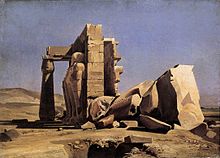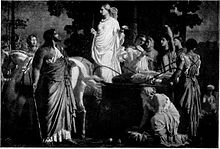- Marc-Charles-Gabriel Gleyre
-
Charles Gleyre (full name Marc Gabriel Charles Gleyre) (Chevilly, Vaud canton, 2 May 1806 – 5 May 1874), was a Swiss artist. He took over the studio of Paul Delaroche in 1843 and taught a number of younger artists who became prominent, including Claude Monet, Pierre Auguste Renoir, Alfred Sisley and James Abbott McNeill Whistler.
His father and mother died when he was eight or nine years of age; and he was brought up by an uncle in Lyon, France, who sent him to the industrial school of that city.
Going to Paris in his late teens, he spent four years in intense artistic study. The following four years Gleyre spent in meditative inactivity in Italy, where he became acquainted with Horace Vernet and Louis Léopold Robert; and six years more were spent wandering in Greece, Egypt, Nubia and Syria. At Cairo he was attacked with ophthalmia, or inflammation of the eye, and in Lebanon he was struck down by fever. He returned to Lyons in shattered health.
On his recovery he proceeded to Paris, and, establishing a modest studio in the rue de Université, began carefully to work out the ideas which had been slowly shaping themselves in his mind. Mention is made of two decorative panels Diana leaving the Bath, and a Young Nubian as almost the first fruits of his genius; but these did not attract public attention until much later, and the painting by which he practically opened his artistic career was the Apocalyptic Vision of St John, sent to the Salon of 1840.
This was followed in 1843 by Evening, which at the time received a medal of the second class, and afterwards became widely popular under the title Lost Illusions. It depicts a poet seated on the bank of a river, with his head drooping and a wearied posture, letting his lyre slip from a careless hand, and gazing sadly at a bright company of maidens whose song is slowly dying from his ear as their boat is borne slowly from his sight.
In spite of the success of these first ventures, Gleyre retired from public competition, and spent the rest of his life in quiet devotion to his artistic ideals, neither seeking the easy applause of the crowd, nor turning his art into a means of aggrandizement and wealth. After 1845, when he exhibited the Separation of the Apostles, he contributed nothing to the Salon except the Dance of the Bacchantes in 1849. Yet he laboured steadily and was productive. He had an "infinite capacity of taking pains," and when asked by what method he attained to such marvellous perfection of workmanship, he would reply, "En y pensant toujours."
Many years often intervened between the first conception of a piece and its embodiment, and years not unfrequently between the first and the final stage of the embodiment itself. A landscape was apparently finished; even his fellow artists would consider it done; Gleyre alone was conscious that he had not "found his sky." His laboriousness became influential on a large number of his younger contemporaries; for when Delaroche gave up his studio of instruction he recommended his pupils to apply to Gleyre, who at once agreed to give them lessons twice a week, and characteristically refused to take any fee or reward.
By instinct and principle he was a confirmed celibate: "Fortune, talent, health, he had everything; but he was married," was his lamentation over a friend. Though he lived in almost complete retirement from public life, he took a keen interest in politics, and was a voracious reader of political journals. For a time, under Louis Philippe, his studio had been the rendezvous of a sort of liberal club. To the last — amid all the disasters that befell his country — he was hopeful of the future, "la raison finira bien par avoir raison." It was while on a visit to the Retrospective Exhibition, opened on behalf of the exiles from Alsace and Lorraine, that he died suddenly on 5 May 1874.
He left unfinished the Earthly Paradise, a noble picture, which Taine has described as "a dream of innocence, of happiness and of beauty — Adam and Eve standing in the sublime and joyous landscape of a paradise enclosed in mountains, a worthy counterpart to the Evening. Among the other productions of his genius are the Deluge, which represents two angels speeding above the desolate earth from which the destroying waters have just begun to retire, leaving visible behind them the ruin they have wrought; the Battle of the Lemanus, a piece of elaborate design, crowded but not encumbered with figures, and giving fine expression to the movements of the various bands of combatants and fugitives; the Prodigal Son, in which the artist has ventured to add to the parable the new element of mother's love, greeting the repentant youth with a welcome that shows that the mother's heart thinks less of the repentance than of the return; Ruth and Boaz; Ulysses and Nausicaa; Hercules at the Feet of Omphale; the Young Athenian, or, as it is popularly called, Sappho; Minerva and the Nymphs; Venus and Adonis; Daphnis and Chloë; and Love and the Parcae. Nor must it be omitted that he left a considerable number of drawings and water-colours, and that we are indebted to him for a number of portraits, among which is the sad face of Heinrich Heine, engraved in the Revue des deux mondes for April 1852. In Clement's catalogue of his works there are 683 entries, including sketches and studies.
References
Fritz Berthoud in Bibliothèque universelle de Geneve (1874); Albert de Montet, Dict. biographique des Genevois et des Vaudois (1877); and Vie de Charles Gleyre (1877), written by his friend, Charles Clement, and illustrated by 30 plates from his works in Hersent's studio, in Suisse's academy, in the galleries of the Louvre.
 This article incorporates text from a publication now in the public domain: Chisholm, Hugh, ed (1911). Encyclopædia Britannica (11th ed.). Cambridge University Press.
This article incorporates text from a publication now in the public domain: Chisholm, Hugh, ed (1911). Encyclopædia Britannica (11th ed.). Cambridge University Press.External links
Categories:- 1806 births
- 1874 deaths
- People from Vaud
- Swiss painters
- Academic art
Wikimedia Foundation. 2010.



